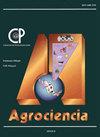温度和紫外线辐射对绿僵菌生长和致病性的影响
IF 0.5
4区 农林科学
Q4 AGRICULTURE, MULTIDISCIPLINARY
引用次数: 0
摘要
昆虫病原真菌在田间的功效取决于各种环境因素的影响,包括温度和紫外线照射水平。推测绿僵菌对甘薯象鼻虫(Cylas formicarius, Fabricius;鞘翅目、锥象鼻虫科)。本研究的目的是评价温度和紫外光辐射对古巴不同原生菌株的生长和致病性的影响,这些菌株具有抗虫的生物活性。在28、30、32和34°C温度下测定菌落直径,并在254 nm紫外光下照射10、15、20、30、30、60和120分钟。在实验室条件下,对菌株LBMa-11、LBM-30、LBM-41和LBM-146的分生孢子发芽率进行了测定,并对其累积死亡率和平均致死时间(TL50)进行了生物测定。结果表明,温度和紫外光对绿僵菌控制白蚁的能力有影响。暴露于紫外线下的所有菌株均发现累积死亡延迟,TL50增加。最佳温度范围为28 ~ 30℃。Probit回归分析结果显示,菌株LBM-127对温度的敏感性最高,菌株LBMa-11对紫外光的耐受性最高,菌株LBM-146的毒力最强。本文章由计算机程序翻译,如有差异,请以英文原文为准。
EFFECT OF TEMPERATURE AND ULTRAVIOLET RADIATION ON GROWTH AND PATHOGENICITY OF Metarhizium anisopliae
The efficacy of entomopathogenic fungi in the field depends on the influence of various environmental factors, including temperature and level of exposure to UV light. It is hypothesized that temperature and level of UV light exposure of Metarhizium anisopliae (Hypocreales, Clavicipiceae) may affect its efficiency in controlling the sweetpotato weevil (Cylas formicarius, Fabricius; Coleoptera, Brentidae). The objective of this study was to evaluate the influence of temperature and ultraviolet light radiation on the growth and pathogenicity of different native strains of Cuban origin of the M. anisopliae Sorokin complex with biological activity against C. formicarius. Colony diameter was measured at 28, 30, 32 and 34 °C temperature and exposed to ultraviolet light (254 nm) for 10, 15, 20, 30, 30, 60 and 120 minutes. Under laboratory conditions, the percentage germination of conidia of strains LBMa-11, LBM-30, LBM-41 and LBM-146 was determined, as well as their pathogenic capacity by means of bioassays with adults of C. formicarius in terms of the percentage of cumulative mortality and the mean lethal time (TL50). Results proved that temperature and UV light affect the ability of M. anisopliae to control C. formicarius. A delay in cumulative mortality was detected for all strains exposed to UV light, with an increase in TL50. The optimum temperature range was between 28 and 30 °C. The strain LBM-127 showed the highest sensitivity to temperature, LBMa-11 the highest tolerance to UV light, and LBM-146 was the most virulent according to Probit regression analysis.
求助全文
通过发布文献求助,成功后即可免费获取论文全文。
去求助
来源期刊

Agrociencia
农林科学-农业综合
CiteScore
0.50
自引率
33.30%
发文量
51
审稿时长
18-36 weeks
期刊介绍:
AGROCIENCIA is a scientific journal created and sponsored by the Colegio de Postgraduados. Its main objective is the publication and diffusion of agricultural, animal and forestry sciences research results from mexican and foreign scientists. All contributions are peer reviewed. Starting in the year 2000, AGROCIENCIA became a bimonthly and fully bilingual journal (Spanish and English versions in the same issue). Since 2007 appears every month and a half (eight issues per year). In addition to the printed issues, the full content is available in electronic format.
 求助内容:
求助内容: 应助结果提醒方式:
应助结果提醒方式:


